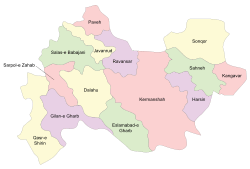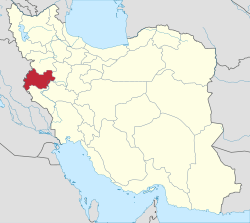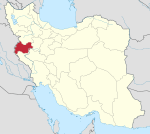Sarpol-e Zahab County
Sarpol-e Zahab County or with Kurdish pronunciation Sarpell-i zahaw (Kurdish: سهرپێڵی زههاو, Serpêllî Zehaw Persian: شهرستان سرپل ذهاب, Šaharestâne Sarpole Zahâb;) is a county in Kermanshah Province in Iran. The capital of the county is Sarpol-e Zahab, whose people are adherents of Shia, Sunni and Yarsan.[1]
Sarpol-e Zahab County شارستانی سەرپێڵی زەھاو | |
|---|---|
 Counties of Kermanshah Province | |
 Location of Kermanshah Province in Iran | |
| Coordinates: 34°35′N 45°50′E | |
| Country | |
| Province | Kermanshah |
| Capital | Sarpol-e Zahab |
| Bakhsh (Districts) | Central District |
| Population (2006) | |
| • Total | 81,428 |
| Time zone | UTC+3:30 (IRST) |
| • Summer (DST) | UTC+4:30 (IRDT) |
| Sarpol-e Zahab County can be found at GEOnet Names Server, at this link, by opening the Advanced Search box, entering "9206874" in the "Unique Feature Id" form, and clicking on "Search Database". | |
The inhabitants speak Kalhori variant of the Sorani dialect of Kurdish. At the 2006 census, the county's population was 81,428, in 18,233 families.[2] The county has one district: the Central District. The county has one city: Sarpol-e Zahab.
Archaeological findings
Archaeologists published in the journal Antiquity in August 2019 about the discovery of a defensive wall named “Gawri wall” or “Gawri Chen Wall” which was found near the present-day Iranian-Iraqi border and stretched about 115 kilometers. It is estimated that, the wall was built during the rule of the Parthians or Sasanians.[3][4]
According to Sajjad Alibeigi, “With an estimated volume of approximately one million cubic meters of stone, it would have required significant resources in terms of workforce, materials and time, remnants of structures, now destroyed, are visible in places along the wall. These may have been associated turrets [small towers] or buildings”.[5][6]
References
- Knowing Sarpol-e-Zahab Retrieved 2 December 2017
- "Census of the Islamic Republic of Iran, 1385 (2006)". Islamic Republic of Iran. Archived from the original (Excel) on 2011-11-11.
- November 2019, Owen Jarus-Live Science Contributor 05. "Ancient 70-Mile-Long Wall Found in Western Iran. But Who Built It?". livescience.com. Retrieved 2020-04-22.
- Alibaigi, Sajjad (2019). "The Gawri Wall: a possible ParthoSasanian structure in the western foothills of the Zagros Mountains" (PDF). Antiquity.
- "Ancient 70-Mile-Long Wall Found in Western Iran. But Who Built It? | ARCHAEOLOGY WORLD". Retrieved 2020-04-22.
- "Ancient 70-mile-long wall found in western Iran". Tehran Times. 2019-11-06. Retrieved 2020-04-22.
External links
| Wikimedia Commons has media related to Sarpol-e Zahab County. |
- اطلس گیتاشناسی استانهای ایران [Atlas Gitashenasi Ostanhai Iran] (Gitashenasi Province Atlas of Iran)
